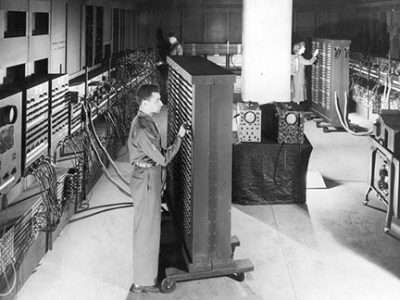With a slew of new initiatives, SEAS is a major player in Penn’s future.
By Judith Rodin
Remember the ad campaign, “This is not your father’s Oldsmobile”? The automaker was trying to shed its image as a maker of boats on wheels by pitching a new line of sportier luxury cars to the nongeriatric car-buying public.
Like the Olds management team, Penn Engineering leaders know when it’s time to change. Mind you, they still revere the proud heritage of the School of Engineering and Applied Science (SEAS), which launched the digital age and for generations has educated some of the world’s most accomplished engineers.
However, Dean Eduardo Glandt and his team also know that we are living through a technological explosion that will revolutionize computing, communications, the life sciences, materials science, and virtually every facet of our global society. With foresight, they have shifted gears to keep pace with these changes by creating a more integrated, interdisciplinary, and, ultimately, a more dynamic approach to teaching and research in engineering.
Scan the academic landscape about Towne, and you will see the exciting future of engineering taking shape. Cutting-edge research centers and initiatives in nanotechnology, bioegineering, and cognitive science have been launched. A state-of-the-art facility for computer science is going up. The curriculum for undergraduate education is changing to produce graduates who can flourish in engineering—or in medicine, business, and law. Exceptional SEAS undergraduates are cranking out their own breakthrough research, designs, and discoveries.
Truly, this is not your father’s engineering school.
Think of SEAS as the nimble engineering school that could power its faculty, students, and all of Penn to new heights of technological prowess and achievement.
The power of Penn Engineering begins with faculty-driven research and outreach to industry. Under Dean Glandt’s leadership and the operational command of Deputy Dean (and distinguished scholar) Vijay Kumar, SEAS is mining the expanding nexus between engineering and its applications in the life sciences to propel Penn to the forefront with new collaborative research initiatives in materials science, bioinformatics, and advanced computing.
Take the nascent but promising field of nanotechnology, the science of developing tools and machines as small as a single molecule. Merging the disciplines of engineering, condensed-matter physics, molecular biology, and chemistry, nanotechnology could bring us life-saving products such as microscopic capsules that selectively deliver drugs to tumors, as well as a wide array of molecular devices to make computers much faster and manufacturing much cleaner and less expensive.
Nanotech may prove the biggest technology breakthrough since the invention of the transistor, but it will take a fluid collaboration of engineers, physicists, chemists, and biomedical researchers to translate the nano concept into practice.
So far, less than three dozen universities nationwide have broken out of the gate to launch nanotechnology research centers. It should come as no surprise that Penn belongs in that elite company.
A year ago, Penn established the Center for Science and Engineering of Nanoscale Systems (SENS) to foster collaborative faculty research among seven departments across three schools: Engineering, Medicine, and Arts and Sciences. Directed by Penn Materials Science Professor Dawn Bonnell, SENS is already in the forefront of many areas of nanoscale research, including molecular and nanoelectronics, single-molecule and membrane mechanics, carbon nanotubes, and computational nanotechnology.
Not long before the launch of SENS, the Commonwealth of Pennsylvania gave Penn and neighboring Drexel University the green light and greenbacks to create a Regional Nanotechnology Center. Co-directed by Penn’s David Luzzi, associate professor of materials science and engineering, this center can leverage our own research strengths at SENS and our combined firepower with Drexel into the next generation of high-tech products and jobs. It is not far-fetched to imagine the Delaware Valley renamed “Nanotech Valley.”
Penn, of course, has long been a national leader in materials science. Its Laboratory for Research on the Structure of Matter, which ranks second among 15 centers nationwide in National Science Foundation support, brings together 36 researchers from SEAS, SAS, and the School of Medicine. These researchers work closely with industry and other economic sectors to create new materials that could potentially revolutionize consumer and industrial products.
Penn Engineering has also taken major strides toward becoming a national leader in harnessing the power of computing, which not only is integral to all facets of engineering, but is also driving the future of communications, medicine, business, and distributive learning. The projected opening later this year of the Melvin J. and Claire Levine Hall, a spectacular facility that will double the space for the Department of Computer and Information Science, and the recent appointment of Dr. Fernando Pereira, a scholar of international renown in computational linguistics and artificial intelligence, underscore Penn’s march to academic computing dominance.
Penn is also pushing forward to capitalize on its formidable interdisciplinary strengths in bioengineering, epitomized by the Institute for Medicine and Engineering. Building a state-of-the-art facility for the Department of Bioengineering is critical to the recruitment of faculty and development of new research and education programs in this burgeoning field, which develops life-saving medical devices and diagnostic tools.
The drive to give bioengineering a new home worthy of its stature and potential got a major boost last year when Penn won a $14 million grant from the Whitaker Foundation. Bringing the Whitaker initiative to fruition will remain a high University priority.
Of course, providing Penn Engineering students with a dynamic and superior education that opens pathways to exciting research opportunities and rewarding careers remains our top goal.
Judging by the quality and performance of our current crop of students, Penn Engineering is achieving this goal. Consider these achievements:
- Last year, a team of computer and tele-communications engineering students developed an educational software tool that teaches students the fundamentals of quantum computing.
- University Scholar Kiran Thadani, a double major in physics and systems science and engineering, has drafted a paper on her pioneering work with single-wall carbon nanotubes that may appear in a peer-reviewed journal.
- CSE and math major Dan Rudoy is developing algorithms for tele-immersion, a new technology that creates the visual sensation of physical nearness to people and objects that in reality can be thousands of miles away.
- Navy ROTC student and electrical engineering major Charles Adams is a digital media phenom who has helped develop a game that simulates the movements of crowds and individuals within the crowd. (This kind of program can be used in training simulations for the military and law enforcement.)
These students, and scores more like them, are the vanguard of the next generation of engineering students. They work beautifully in teams. They gravitate toward multiple academic interests and dual majors. They thrive on exposure to the rich array of clinical research opportunities at Penn. They move fluidly across a broad range of disciplines. They find ways to bring the wonders of technology to the community, and they are developing the knack for leadership in virtually any profession.
Imparting the skills of engineering and cultivating the instinct for entrepreneurship, creativity, and leadership have become the primary educational thrusts at SEAS.
In a remarkable burst of activity, the school has inaugurated the Engineering Entrepreneurship Program and expanded its roster of bold dual-degree offerings. It has also engineered the popular Digital Media Design major, a triumphant collaboration with the Annenberg School for Communication and the Graduate School of Fine Arts.
Next fall, the school will launch a pilot EAS 100 course, which will provide first-year students with a dynamic multidisciplinary introduction to engineering, teamwork, communications, leadership, and professional ethics. Penn Engineering truly is creating the matrix for an exciting learning experience that will continue to attract many of the most talented, capable, and energetic students in the world.
If, in the parlance of today’s students, “technology rules,” then the University community will come to view Penn Engineering students, faculty, and staff as technology’s stewards. The plan to build the Weiss Tech House, a campus science-and-technology hub made possible by a gift from alumnus George Weiss W’65, sends a powerful signal to the Penn community that SEAS is no longer a world unto its own.
Penn Engineering has played a big part in the University of Pennsylvania’s history. With a new, reinvigorated focus on technology and innovation, Penn Engineering has emerged as a major player in Penn’s future.




